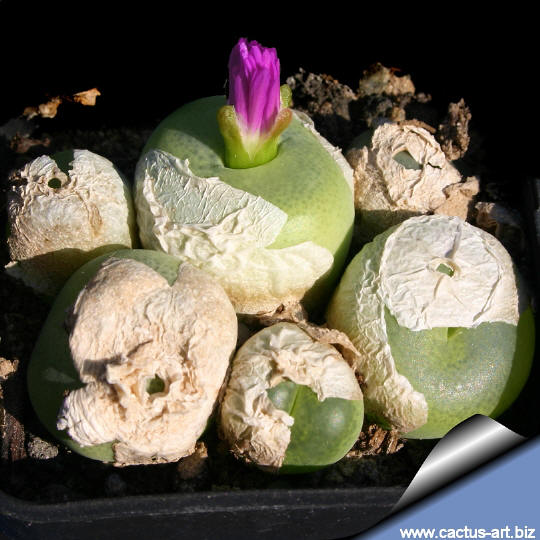|
|
|
Family: Mesebrianthemaceae (Aizoaceae)
Scientific name: Conophytum
pillansii Lavis ex L.Bolus
in: S. African Gard. 19:144. 1929
Origin: Knersvlakte - Namaqualand.
Synonyms:
|
|
Description:
C. pillansii is one of the larger
species, it stays single or (usually) clusters to form large cushion
(Groundcover)
Body (leaves): Bodies soft,
up to 2.5 cm in diameter and tall somewhat globose or nearly
flat-topped, pale green, translucent,
with many green spots,
with a growing cleft that doesn't reach right across the body.
Flowers: Usually scented, large,
daisy-like, purplish red, pink or, rarely, white, they are very
showy.
Blooming season: Blooms mostly Aug-Nov.
|
|
|
|

CONOPHYTUMS: Plants of the genus Conophytum are also
known as 'living pebbles'. During the rest period (the summer
months in Europe) a new body forms inside the old, gradually taking all
the substances from it until all that remains is the skin, which dries
and protects the young plant from the heat of the sun and excess
evaporation of water. The resting Conophytum protected by this dry cover
resembles a pebble and hence the name 'living pebble'. The growth
period of most species is from August to March. The temperature should
be about 10 to 12°C.
Cultivation: C. pillansii is easy to grow. These
plants grow on winter rain and head for summer dormancy. More or less
dormant in summer. The plant requires little water; otherwise its
epidermis breaks (resulting in unsightly scars). Water throughout the
year although minimally in summer, (only when the plant starts
shrivelling), but it will generally grow even in summer if given water.
Water regularly in winter after the previous year's leaves have dried
up. Requires good drainage. Keep cool and shaded from hot sun in
mid-summer; it needs full sun or light shade in the other seasons. Hardy
to -2°C. Ensure a very good ventilation. Avoid to repot frequently. This
plant may stay in the same pot for many years. Plants grown in larger
containers have frequently relatively poor flowers. It might improve
when the plants are given their own, small individual pots.
Propagation: It can be
reproduced both by cuttings and seeds. Take the cutting from a grown-up
mother plant. Each
cutting must contain one or more heads, along with
a fraction of root.


|
|